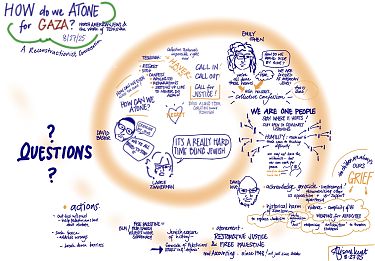13 September 25
Fraught
Last night I finished reading Ta-Nehisi Coates’s The Message, which is divided into three parts: the first deals with his trip to Senegal, the second with time in South Carolina, and the third and longest, a trip to Palestine.
The book came out last year before the current ongoing destruction of, and genocide in, Gaza, but the message resonates even more because of what’s happening now. I am not Jewish, but I’m married to a Jew, and I find this is a fraught tightrope to navigate as a gentile. Netanyahu’s contention that any criticism of Israel or zionism is necessarily anti-semitic has been incredibly effective at silencing criticism. Yet criticism is there and hasn’t abated, as the recent protests throughout northern Spain during the Vuelta a España have demonstrated. The United States funds Israeli violence. I pay taxes which fund Israeli violence. I am complicit in the Palestinian genocide.
And I know this: my Jewish friends and relatives are in agony right now. They are ashamed of the atrocities being done in their name, they are terrified at the new wave of antisemitism the violence has dragged along in its wake, and they don’t know what to do about any of it. The horrors of the Holocaust were real and no amount of German reparations have been able to erase them, but as Mandy Patinkin says, why would you turn around and do this to somebody else? Below is a chart I made during a discussion of these issues a month or so ago from a Reconstructing Judaism perspective.
Ta-Nehisi’s final exhortation is to allow Palestinians to tell their stories. Ever since Edward Said’s death (he was an author of ours when I worked at Harvard University Press and cut a striking figure at conferences), celebrity Palestinian voices have been few and far between. So let’s let the ordinary people speak: those who were removed from their villages during the Naqba, during various violent flare-ups and wars since 1948, by settlers who claim that this land was given to them by God, even though it had been continuously lived on, loved and worked by Palestinian Arabs for over 1,000 years.
If Israel has a right to exist, does it through crimes against humanity forfeit that right? At what point does the international community step in and say Enough? The answer is, it doesn’t, because the United States is in the way. And the triumph of Evangelical Christian Zionism keeps the status quo.
Let the Palestinians speak. Let them tell their stories. Before they’re all wiped off the face of the Earth.
12 September 25
A Notebook Accounting
We watched today’s keynote for the Wild Wonder Conference on nature journaling that is currently taking place. The keynote presentation was given by Roland Allen who recently wrote the book The Notebook: A History of Thinking on Paper, and was billed as an incomplete history of nature notebooks. Allen traces the history of notebooks in Europe back to the introduction of paper manufacturing in Xàtiva in Islamic Spain. This technology gave people cheap and durable surfaces upon which to write, and in Florence the paper was bound into notebooks for common use. Accountants were some of the first ones to take advantage of the technology, inventing double-entry bookkeeping via ledgers. Paper was also a much more satisfying material to draw on than parchment, and this led to the first realistic nature illustrations by individuals such as Conrad Gessner.
Allen is a great advocate of the notebook as a cognitive tool, and he shared some of the different notebooks he keeps. Both Pica and I keep many notebooks as well, and here is a perhaps incomplete list of the ones I have:
- My bullet journal. A list of daily, weekly, and monthly tasks and events, together with notes on various projects. This is a Moleskine gridded notebook.
- My daily journal, entitled “A Journal of The Unraveling”. I complete one page a day in this, and always end the page with a quick sketch of a cat.
- My daily sketchbook, currently in vertical format with the subjects being plant bits.
- A work notebook, which I mostly used for taking notes on conference calls.
- A nature journal. Unlike most of the attendees at the conference, I rarely make entries in it.
- A notebook of astronomy observations.
- A notebook for my Catalan studies. I don’t seem to have a notebook for Spanish, and instead use a card file to record interesting words.
- A notebook of Hebrew vocabulary from the Duolingo course which I got through in spring of 2022.
- A notebook of astronomy observations.
- Two notebooks from the days when I was actively doing radio. First, a logbook of my ham radio contacts on HF.
- Second, a notebook of interesting shortwave radio loggings.
- And a miscellany of other sketchbooks.
11 September 25
Wild Wonder
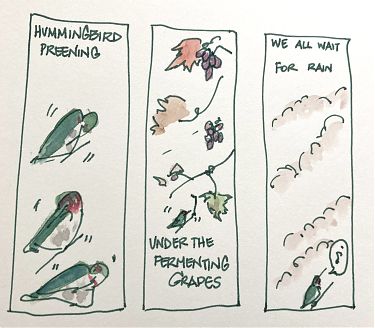 The Wild Wonder Conference is going on at the moment. Numenius gave me a conference pass as a birthday present and this year they are spreading it out over several days instead of having concurrent sessions, which is great. It’s been happening for several years now, the brainchild of Bay Area artist and educator John Muir Laws, who has been a major part of the nature journaling wave which is now worldwide and who came and taught a bird drawing workshop for us at Yolo Audubon over 20 years ago. The keys to nature journaling: see; observe; wonder; associate (ISIWIRMO=I see, I wonder, it reminds me of).
The Wild Wonder Conference is going on at the moment. Numenius gave me a conference pass as a birthday present and this year they are spreading it out over several days instead of having concurrent sessions, which is great. It’s been happening for several years now, the brainchild of Bay Area artist and educator John Muir Laws, who has been a major part of the nature journaling wave which is now worldwide and who came and taught a bird drawing workshop for us at Yolo Audubon over 20 years ago. The keys to nature journaling: see; observe; wonder; associate (ISIWIRMO=I see, I wonder, it reminds me of).
Nature journaling is a practice I return to intermittently and every time I do I wish I’d been more consistent. Yesterday I was able to take a workshop by Grant Snider on poetry nature comics; this intersection was an intriguing challenge for me. Naturally I tackled hummingbirds, since that is very much where my interest is these days.
10 September 25
Game Of Cones
 Winston Cat was full of high rambunctious energy last night, and we found a new game to play. Here is a bit of video from the game.
Winston Cat was full of high rambunctious energy last night, and we found a new game to play. Here is a bit of video from the game.
9 September 25
Arboretum Outing
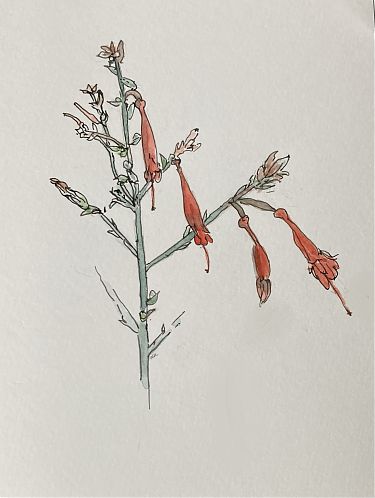 I took myself off to the Arb this morning to study this plant in preparation for my hummingbird project. We have some of these plants much closer to home but it was a cool morning and I wanted to try out this new paper. In the event that was complicated but I’m quite pleased with this drawing, though the pen lines are too dark: I’d use red or brown ink, I think.
I took myself off to the Arb this morning to study this plant in preparation for my hummingbird project. We have some of these plants much closer to home but it was a cool morning and I wanted to try out this new paper. In the event that was complicated but I’m quite pleased with this drawing, though the pen lines are too dark: I’d use red or brown ink, I think.
On the way home I saw a flock of wild turkeys around the Arneson sculpture, Eye on Mrak (The Last Laugh).
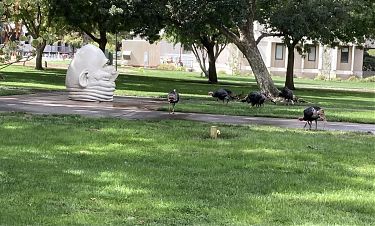
8 September 25
The Jujube AI
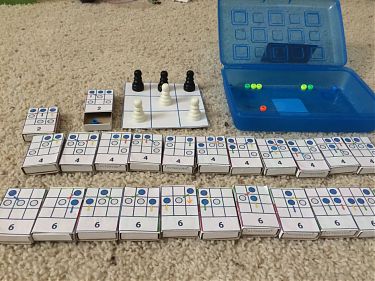 When I was a child, my mother and I crafted an AI out of a set of matchboxes and some jujubes (the small colored gummy candies). I enjoyed reading Scientific American when I was young, and at one point found an intriguing article by Martin Gardner, the columnist who wrote Mathematical Games for 25 years. This article was entitled A Matchbox Game-Learning Machine and was published in 1962 — I probably ran across it in a reprinted book collection.
When I was a child, my mother and I crafted an AI out of a set of matchboxes and some jujubes (the small colored gummy candies). I enjoyed reading Scientific American when I was young, and at one point found an intriguing article by Martin Gardner, the columnist who wrote Mathematical Games for 25 years. This article was entitled A Matchbox Game-Learning Machine and was published in 1962 — I probably ran across it in a reprinted book collection.
Gardner’s article shows how to build an analog learning machine to play a simple game called hexapawn which involves moving pawns on a 3×3 chessboard. The rules are given in the article linked above. At right is a photo from a much more recent Instructables article showing the setup. In the game the human player moves first as white. The machine plays the black side. The system works as follows. On top of the boxes are diagrams illustrating all the possible states of the game after moves 2, 4, and 6 (the game can last no more than 7 moves) and the possible moves for black illustrated in different colored arrows. Inside each box are colored beads (or jujubes in my case) corresponding to the colored arrows on top. After the human moves, they find the box corresponding to the state of the game, randomly draw a colored bead on the top, and have black carry out the move indicated on the top by the corresponding arrow. The bead is set aside, and if black loses the game, the bead representing the final move is discarded from the machine. That way the machine learns that the final move is an incorrect one to take.
It turns out that given optimal play, black is guaranteed to win, and it doesn’t take very many rounds for the machine to become invincible — somewhere around 30 or 40 games played.
Does this qualify as AI? Absolutely. This demonstrates that machine learning doesn’t require digital computers. Admittedly, this approach doesn’t scale very well: Gardner’s hexapawn example with 24 matchboxes was based on an earlier system for tic-tac-toe that needs over 300 matchboxes.
I am interested in other examples of analog AI. In particular, contemporary board games often have subsystems for solitaire play that can be quite hard to beat. These generally do not learn from experience, but they do respond to current states of the game by setting goals and carrying out actions.
7 September 25
The Spanish Spoken in Chile: A Dialect or a Language?
I’ve long been a fan of La Linguriosa (Elena Herraiz), a Spanish linguist with a “superinteresante” YouTube channel. In the video released today, she’s talking about Chilean Spanish. It’s true that when spoken quickly by people whose education deprived them of learning standard Spanish, Chilean Spanish can be difficult to understand. I remember working in an office in Madrid in the early 1980s, when one of the secretaries (a refugee from Pinochet’s excesses?) introduced me to certain Chilean phonemes (especially “ch” for “tr,” as in nosochos instead of nosotros).
Language is a source of constant interest and joy for me. I’ve started playing Lingule daily along with Wordle, Geoguesser and bridge (massively fail on Australian indigenous and African languages, but I’m learning).
6 September 25
The Queen of Passports
I have been reading Kai Bird and Martin Sherwin’s biography of J. Robert Oppenheimer, American Prometheus, the long tome that was the inspiration for the recent movie “Oppenheimer”. At one point the book discusses the Berkeley-based chemist Martin D. Kamen who in 1940 together with Sam Ruben was the first to synthesize carbon-14 in a cyclotron and who went on to use this carbon isotope to investigate the biochemical reactions involved in photosynthesis in 1941. He then was recruited to work on the Manhattan Project, but in 1944 a couple of incidents led him to be unjustly accused of espionage, and he was blacklisted for many years until finally winning his legal battles in 1955.
One of these battles was getting his passport back, which was revoked in 1947 by one Ruth B. Shipley, the head of the Passport Division of the State Department. It turns out that between 1928 and 1955, all decisions about issuances of passports ran through Mrs. Shipley, and they were not subject to judicial review. Depending on one’s perspective, she was both greatly admired and feared. Franklin Delano Roosevelt praised her as being a “wonderful ogre”. In the era of anti-communist hysteria she denied passports to many people in addition to Kamen, including the actor Paul Robeson, the playwright Arthur Miller, and the chemist Linus Pauling. She retired in 1955 at the mandatory age of 70, and at this point her power was starting to wane. The denial of the passport to Linus Pauling elicited the wrath of Senator Wayne Morse, and Pauling did obtain his full passport to be able to travel to Stockholm to receive his Nobel Prize for chemistry in 1954.
Jeffrey Kahn discusses Mrs. Shipley’s career in an article in the Connecticut Law Review published in 2011. He compares the reign of Mrs. Shipley with contemporary screening systems. Kahn views today’s systems e.g. the Terrorist Screening Database and its subset the No Fly List as the digital descendants of Mrs. Shipley’s files. But there is no longer a single authority governing who is in these databases, and responsibility for them has disappeared into anonymity.
5 September 25
Podiatry Visit
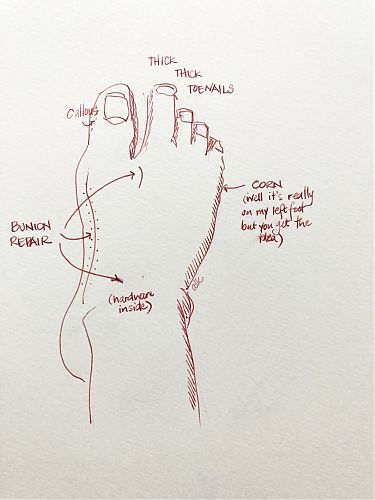 I’ve reached the age where regular visits to the podiatrist seem to be part of my life. I can’t successfully cut a few of my toenails and I have a corn which needs to be shaved with a knife and which is in a very awkward place to do myself.
I’ve reached the age where regular visits to the podiatrist seem to be part of my life. I can’t successfully cut a few of my toenails and I have a corn which needs to be shaved with a knife and which is in a very awkward place to do myself.
I did go to get pedicures a lot while I was working. Different feel, the podiatrist’s office. I’m glad I’ve made the shift. My feet have a lot of issues and they deserve the care.
4 September 25
Videolets
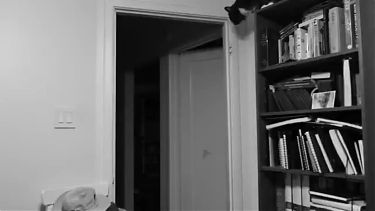 I have been continuing my project of cataloging all my photos, and have launched into the subproject of organizing the video snippets I have. Video baffles me a good bit, coming from a background in still photography. There are many situations where a bit of video captures a subject or a scene much better than a still photograph — think of imaging a river at full flood — but such snippets even if edited together don’t make for a full-fledged video. Or to put it another way, if YouTube videos are the dominant force in video production these days, they are rhetorically a very different medium from still photography even if the stills are augmented with a bit of video.
I have been continuing my project of cataloging all my photos, and have launched into the subproject of organizing the video snippets I have. Video baffles me a good bit, coming from a background in still photography. There are many situations where a bit of video captures a subject or a scene much better than a still photograph — think of imaging a river at full flood — but such snippets even if edited together don’t make for a full-fledged video. Or to put it another way, if YouTube videos are the dominant force in video production these days, they are rhetorically a very different medium from still photography even if the stills are augmented with a bit of video.
Maybe the way forward is to embrace video snippets as their own art form — let’s call them videolets. These could work well in a blogging context, for one thing.
In this light, here is a videolet of Winston making a big leap. At night he likes to sleep on top of the bookcase in my office. But he usually takes a shortcut to get down from the bookcase!

